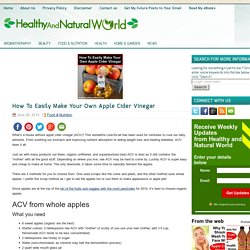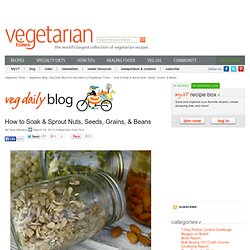

Pineapple Turmeric Sauerkraut and Gut Shots. Wow do I have a treat for you!

Over the weekend I had a Kraut Party. A few of my friends came over and I showed them how to make their own sauerkraut. I’ve been persuading my friends to try making it themselves, so in order to give them confidence, I showed them how to do it. At the end of the day, they said it was so much easier to make than they thought and they drank all the gut shots. Mission accomplished!
For the Kraut Party, I made a variety of fermented foods for them to try.
Pickeled. Fermented drinks. Cheese. How To Easily Make Your Own Apple Cider Vinegar. What’s a house without apple cider vinegar (ACV)?

This wonderful cure-for-all has been used for centuries to cure our daily ailments. From soothing our stomach and improving nutrient absorption to aiding weight loss and treating diabetes, ACV does it all. Just as with many products out there, organic unfiltered, and unpasteurized (raw) ACV is best as it still contains the “mother” with all the good stuff. Depending on where you live, raw ACV may be hard to come by. Luckily ACV is super easy and cheap to make at home. There are 2 methods for you to choose from. Since apples are at the top of the list of the fruits and veggies with the most pesticides for 2014, it’s best to choose organic apples. ACV from whole apples What you need 6 sweet apples (organic are the best)Starter culture: 2 tablespoons raw ACV with “mother” or scoby (if you use your own mother, add 1/3 cup. 3 Easy Ways to Make Probiotic-rich Fermented Foods.
Anna Hunt, Staff WriterWaking Times Fermented, probiotic foods, filled with beneficial bacteria, have been common in many cultures and are an integral part of a healthy diet.

Yet, as we’ve become more modernized, it has become less convenient to ferment our own foods. We eat shelf-friendly, lifeless, pre-packaged foods that have been sterilized, pasteurized, and denatured, and we live in sterilized environments. As a result, the gut biome is suffering, which makes it more difficult for people to fight off bad bacteria and creates a variety of health issues. The importance of a healthy gut flora cannot be underestimated. Frugal and Simple Archives - Nourishing Simplicity. What if I told you that you could heal your family naturally and save money at the same time?

Making your own tincture may seem overwhelming, but it doesn’t have to be. If you follow these 6 easy steps to make an herbal tincture you will see how simple it really is. Have you ever walked down the aisle at a health store? Tinctures are not cheap, the price is enough to scare any frugal gal away. Tinctures don’t have to be that expensive. Supply List Herbs (My favorite stores to buy herbs are Bulk Herb Store and Mountain Rose Herbs)Mason JarVodkaCheese Cloth or Flour Sack TowelSmall Glass Bottles with Droppers 1. I try to stick with a 80-100 proof vodka. 2. How to Make Yeast. Edit Article Two Methods:Making Yeast from Malt ExtractMaking Yeast Starter from Potato.

Soaking and Sprouting Nuts, Seeds, Grains, and Beans. Nuts, seeds, grains, and beans are nutritional powerhouses.

However, the natural agents that protect them from early germination can wreak havoc in our digestive system. Soaking and sprouting replicates germination, which activates and multiplies nutrients (particularly Vitamins A, B, and C), neutralizes enzyme inhibitors, and promotes the growth of vital digestive enzymes. Soaking and sprouting is very easy.
The method is exactly the same for nuts, seeds, grains, and beans—only the time required for full germination changes. (See the table below.) Please note: Many “raw” nuts and seeds have been pasteurized and irradiated. PLACE in a large glass bowl or mason jar, and cover with warm, filtered water (about a 2:1 ratio) and about ½ tsp. RINSE food thoroughly and drain. USE these activated “non sprouts” immediately to make plant-based “milks.” DEHYDRATE in a food dehydrator at no higher than 115º F for 12 to 24 hours, and store in sealed glass containers in the fridge. Canned Salsa. Simplifying Probiotics – A Path To Improving Your Gut Health. Anna Hunt, Staff WriterWaking Times Billions of beneficial bacteria, commonly referred to as probiotics, live in the human body.

These bacteria are part of what keeps the body in balance in order to maintain overall good health. They reside in the human digestive system, specifically the intestinal tract also referred to as the gut, (as well as in the mouth, on the skin, in the colon, etc), and are integral to gastrointestinal functions.
Over recent years, scientists are starting to discover that these microorganisms also play a role in immunological, metabolic, and neurological diseases. Common Types of Probiotics The best known of the probiotics are the Lactobacilli. . - Lactobacillus delbrueckii subsp. bulgaricus is found in naturally fermented foods and is also used by the dairy industry to produce yogurt. - Lactobacillus acidophilus is naturally-occurring in the human gastrointestinal tract.
. - Other common Lactobacilli species include brevis, casei and sporogenes. Resource Books: Sources: Healthy Green Kitchen Condiments, Preserved Foods Archives » Healthy Green Kitchen.